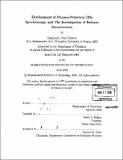| dc.contributor.advisor | Keith A. Nelson. | en_US |
| dc.contributor.author | Paxton, Benjamin John | en_US |
| dc.contributor.other | Massachusetts Institute of Technology. Dept. of Chemistry. | en_US |
| dc.date.accessioned | 2007-02-21T13:17:38Z | |
| dc.date.available | 2007-02-21T13:17:38Z | |
| dc.date.copyright | 2006 | en_US |
| dc.date.issued | 2006 | en_US |
| dc.identifier.uri | http://hdl.handle.net/1721.1/36264 | |
| dc.description | Thesis (Ph. D.)--Massachusetts Institute of Technology, Dept. of Chemistry, 2006. | en_US |
| dc.description | Vita. | en_US |
| dc.description | Includes bibliographical references (p. 155-162). | en_US |
| dc.description.abstract | This thesis develops phonon-polariton based THz spectroscopy and uses this technique to make the first THz frequency dielectric measurements of a relaxor ferroelectric crystal, in particular KTao0.982Nb0.018O3 (KTN 1.8). THz spectroscopy has emerged as an important probe for a wide variety of systems with the development of pulsed THz radiation sources and time-domain detection methods. Four factors motivate the use of phonon-polaritons generated in an ionic crystal (typically LiNbO3 or LiTaO3) via impulsive stimulated Raman scattering as a THz source for spectroscopy: (1) the versatility of phonon-polariton waveform shaping and detection, (2) the ability to use the ionic crystal as a compact, integrated spectroscopic platform, (3) the high THz refractive index of the host material facilitates coupling of THz radiation into high-dielectric samples, and (4) the potential to generate large amplitude polariton fields for nonlinear THz spectroscopy. Here we demonstrate both reflection and transmission implementations of THz spectrometers based on grating interferometric measurement of the phase and amplitude of a phonon-polariton waveform before and after interaction with a sample. | en_US |
| dc.description.abstract | (cont.) A simple implementation of free space THz spectroscopy with conventional detection is also performed as a comparison to the polariton spectroscopy measurements. For the investigation of high-dielectric materials, both reflection and transmission polariton spectroscopy offer clear advantages over free space methods. Polariton spectroscopy is used to measure the refractive index of KTN 1.8 in the -50-250 GHz range from 4-300 K as the index varies between -10 and 35. At low temperatures, the Nb ions in our sample induce dynamically fluctuating polar nano-regions (PNRs) that dominate the dielectric response at low at low frequencies (< 10-7 Hz). Our results differed from low frequency measurements in two ways: a significantly smaller, but still ionic, dielectric response and Curie-Weiss soft mode behavior. Together with ISRS transient grating measurements of the KTN soft mode in the low temperature disordered state, we attribute this behavior to soft mode mediated fast Nb intersite hopping separated from slower PNR dynamics. | en_US |
| dc.description.statementofresponsibility | by Benjamin John Paxton. | en_US |
| dc.format.extent | 162, [1] p. | en_US |
| dc.language.iso | eng | en_US |
| dc.publisher | Massachusetts Institute of Technology | en_US |
| dc.rights | M.I.T. theses are protected by copyright. They may be viewed from this source for any purpose, but reproduction or distribution in any format is prohibited without written permission. See provided URL for inquiries about permission. | en_US |
| dc.rights.uri | http://dspace.mit.edu/handle/1721.1/7582 | |
| dc.subject | Chemistry. | en_US |
| dc.title | Development of phonon-polarization THz spectroscopy, and the investigation of relaxor ferroelectrics | en_US |
| dc.title.alternative | Investigation of relaxor ferroelectrics | en_US |
| dc.type | Thesis | en_US |
| dc.description.degree | Ph.D. | en_US |
| dc.contributor.department | Massachusetts Institute of Technology. Department of Chemistry | |
| dc.identifier.oclc | 77462823 | en_US |
